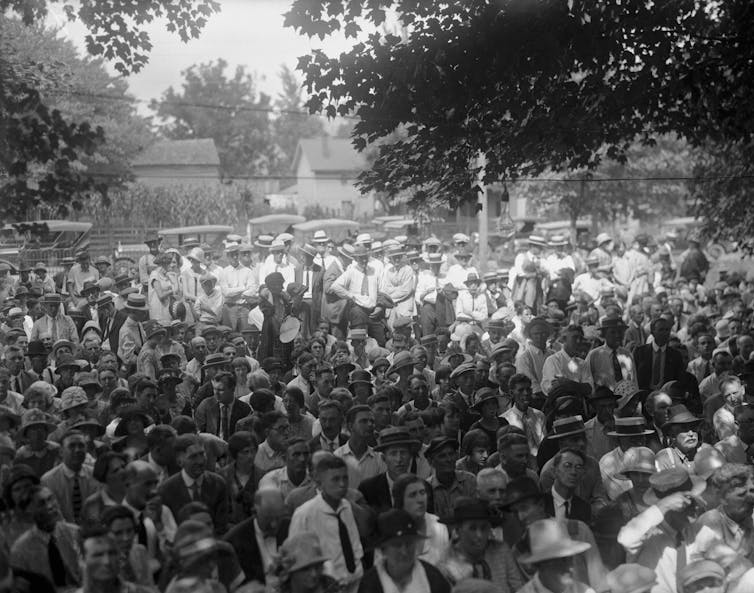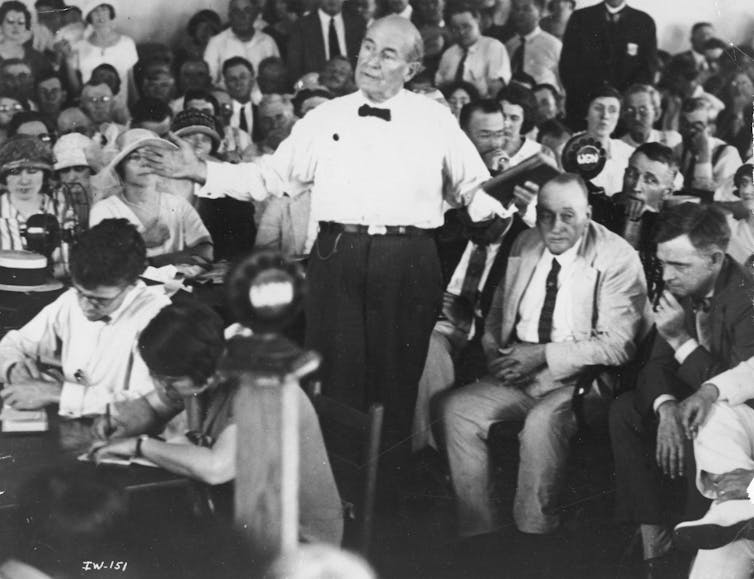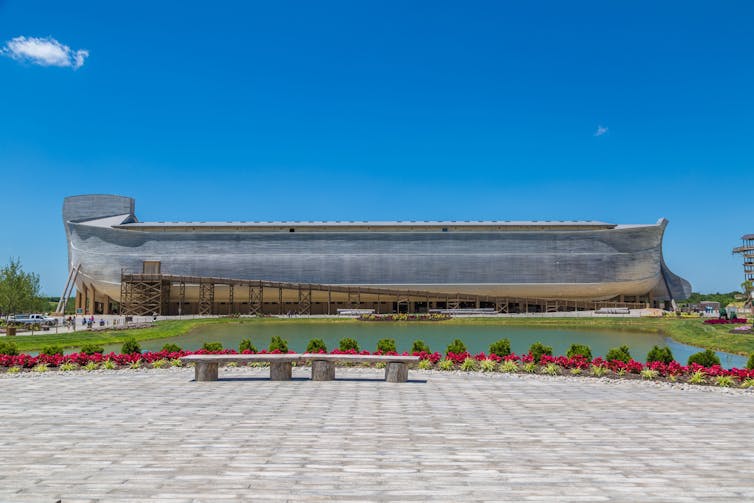(The Conversation) — The 1925 Scopes trial, in which a Dayton, Tennessee, teacher was charged with violating state law by teaching biological evolution, was one of the earliest and most iconic conflicts in America’s ongoing culture war.
Charles Darwin’s “Origin of Species,” published in 1859, and subsequent scientific research made the case that humans and other animals evolved from earlier species over millions of years. Many late-19th-century American Protestants had little problem accommodating Darwin’s ideas – which became mainstream biology – with their religious commitments.
But that was not the case with all Christians, especially conservative evangelicals, who held that the Bible is inerrant – without error – and factually accurate in all that it has to say, including when it speaks on history and science.
The Scopes trial occurred July 10-21, 1925. Between 150 and 200 reporters swooped into the small town. Broadcast on Chicago’s WGN, it was the first trial to be aired live over radio in the United States.
One hundred years after the trial, and as we have documented in our scholarly work, the culture war over evolution and creationism remains strong – and yet, when it comes to creationism, much has also changed.
The trial
In May 1919, over 6,000 conservative Protestants gathered in Philadelphia to create, under the leadership of Baptist firebrand William Bell Riley, the World’s Christian Fundamentals Association, or WCFA.
Holding to biblical inerrancy, these “fundamentalists” believed in the creation account detailed in chapter 1 of Genesis, in which God brought all life into being in six days. But most of these fundamentalists also accepted mainstream geology, which held that the Earth was millions of years old. Squaring a literal understanding of Genesis with an old Earth, they embraced either the “day-age theory” – that each Genesis day was actually a long period of time – or the “gap theory,” in which there was a huge gap of time before the six 24-hour days of creation.
This nascent fundamentalist movement initiated a campaign to pressure state legislatures to prohibit public schools from teaching evolution. One of these states was Tennessee, which in 1925 passed the Butler Act. This law made it illegal for public schoolteachers “to teach any theory that denies the story of divine creation of man as taught in the Bible, and to teach instead that man has descended from a lower order of animals.”
The American Civil Liberties Union persuaded John Thomas Scopes, a young science teacher in Dayton, Tennessee, to challenge the law in court. The WCFA sprang into action, successfully persuading William Jennings Bryan – populist politician and outspoken fundamentalist – to assist the prosecution. In response, the ACLU hired famous attorney Clarence Darrow to serve on the defense team.

A huge crowd attending the Scopes trial.
Bettmann/Contributor via Getty Images
When the trial started, Dayton civic leaders were thrilled with the opportunity to boost their town. Outside the courtroom there was a carnivalesque atmosphere, with musicians, preachers, concession stands and even monkeys.
Inside the courtroom, the trial became a verbal duel between Bryan and Darrow regarding science and religion. But as the judge narrowed the proceedings to whether or not Scopes violated the law – a point that the defense readily admitted – it seemed clear that Scopes would be found guilty. Many of the reporters thus went home.
But the trial’s most memorable episode was yet to come. On July 20, Darrow successfully provoked Bryan to take the witness stand as a Bible expert. Due to the huge crowd and suffocating heat, the judge moved the trial outdoors.
The 3,000 or so spectators witnessed Darrow’s interrogation of Bryan, which was primarily intended to make Bryan and fundamentalism appear foolish and ignorant. Most significant, Darrow’s questions revealed that, despite Bryan’s’ assertion that he read the Bible literally, Bryan actually understood the six days of Genesis not as 24-hour days, but as six long and indeterminate periods of time.

American lawyer and politician William Jennings Bryan during the Scopes trial in Dayton, Tenn.
Hulton Archive/Getty Image
The very next day, the jury found Scopes guilty and fined him US$100. Riley and the fundamentalists cheered the verdict as a triumph for the Bible and morality.
The fundamentalists and ‘The Genesis Flood’
But very soon that sense of triumph faded, partly because of news stories that portrayed fundamentalists as ignorant rural bigots. In one such example, a prominent journalist, H. L. Mencken, wrote in a Baltimore Sun column that the Scopes trial “serves notice on the country that Neanderthal man is organizing in these forlorn backwaters of the land.”
The media ridicule encouraged many scholars and journalists to conclude that creationism and fundamentalism would soon disappear from American culture. But that prediction did not come to pass.
Instead, fundamentalists, including WCFA leader Riley, seemed all the more determined to redouble their efforts at the grassroots level.
But as Darrow’s interrogation of Bryan made obvious, it was not easy to square a literal reading of the Bible – including the six-day creation outlined in Genesis – with a scientific belief in an old Earth. What fundamentalists needed was a science that supported the idea of a young Earth.
In their 1961 book, “The Genesis Flood: The Biblical Record and its Scientific Implications, fundamentalists John Whitcomb, a theologian, and Henry Morris, a hydraulic engineer, provided just such a scientific explanation. Making use, without attribution, of the writings of Seventh-day Adventist geologist George McCready Price, Whitcomb and Morris made the case that Noah’s global flood lasted one year and created the geological strata and mountain ranges that made the Earth seem ancient.
“The Genesis Flood” and its version of flood geology remains ubiquitous among fundamentalists and other conservative Protestants.
Young Earth creationism
Today, opinion polls reveal that roughly one-quarter of all Americans are adherents of this newer strand of creationism, which rejects both mainstream geology as well as mainstream biology.

Replica of Noah’s Ark at the Ark Encounter, near Williamstown, Ky.
Ron Buskirk/UCG/Universal Images Group via Getty Images
This popular embrace of young Earth creationism also explains the success of Answers in Genesis – AiG – which is the world’s largest creationist organization, with a website that attracts millions of visitors every year.
AiG’s tourist sites – the Creation Museum in Petersburg, Kentucky, and the Ark Encounter in Williamstown, Kentucky – have attracted millions of visitors since their opening in 2007 and 2016. Additional AiG sites are planned for Branson, Missouri, and Pigeon Forge, Tennessee.
Presented as a replica of Noah’s Ark, the Ark Encounter is a gigantic structure – 510 feet long, 85 feet wide, 51 feet high. It includes representations of animal cages as well as plush living quarters for the eight human beings who, according to Genesis chapters 6-8, survived the global flood. Hundreds of placards in the Ark make the case for a young Earth and a global flood that created the geological strata and formations we see today.
Ark Encounter has been the beneficiary of millions of dollars from state and local governments.
Besides AiG tourist sites, there is also an ever-expanding network of fundamentalist schools and homeschools that present young Earth creationism as true science. These schools use textbooks from publishers such as Abeka Books, Accelerated Christian Education and Bob Jones University Press.
The Scopes trial involved what could and could not be taught in public schools regarding creation and evolution. Today, this discussion also involves private schools, given that there are now at least 15 states that have universal private school choice programs, in which families can use taxpayer-funded education money to pay for private schooling and homeschooling.
In 1921, William Bell Riley admonished his opponents that they should “cease from shoveling in dirt on living men,” for the fundamentalists “refuse to be buried.” A century later, the funeral for fundamentalism and creationism seems a long way off.
(William Trollinger, Professor of History, University of Dayton. Susan L Trollinger, Professor of English, University of Dayton. The views expressed in this commentary do not necessarily reflect those of Religion News Service.)







